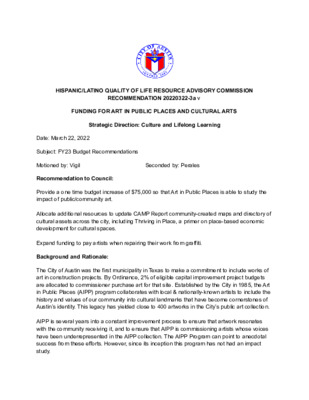RECOMMENDATION 20220322-003a: FUNDING FOR ART IN PUBLIC PLACES AND CULTURAL ARTS — original pdf
Recommendation

HISPANIC/LATINO QUALITY OF LIFE RESOURCE ADVISORY COMMISSION RECOMMENDATION 20220322-3aⅴ FUNDING FOR ART IN PUBLIC PLACES AND CULTURAL ARTS Strategic Direction: Culture and Lifelong Learning Date: March 22, 2022 Subject: FY23 Budget Recommendations Motioned by: Vigil Seconded by: Perales Recommendation to Council: Provide a one time budget increase of $75,000 so that Art in Public Places is able to study the impact of public/community art. Allocate additional resources to update CAMP Report community-created maps and directory of cultural assets across the city, including Thriving in Place, a primer on place-based economic development for cultural spaces. Expand funding to pay artists when repairing their work from graffiti. Background and Rationale: The City of Austin was the first municipality in Texas to make a commitment to include works of art in construction projects. By Ordinance, 2% of eligible capital improvement project budgets are allocated to commissioner purchase art for that site. Established by the City in 1985, the Art in Public Places (AIPP) program collaborates with local & nationally-known artists to include the history and values of our community into cultural landmarks that have become cornerstones of Austin’s identity. This legacy has yielded close to 400 artworks in the City’s public art collection. AIPP is several years into a constant improvement process to ensure that artwork resonates with the community receiving it, and to ensure that AIPP is commissioning artists whose voices have been underrepresented in the AIPP collection. The AIPP Program can point to anecdotal success from these efforts. However, since its inception this program has not had an impact study. Economic Development’s AIPP program will work with a contractor to study the impact of public/community art on our shared civic spaces. This is particularly important in communities where art has been an expression of the shared experience of Austin’s traumatized communities, such as is visible in the murals of East Austin. The AIPP program will seek recommendations for best practices from the evaluation consultant to: ● Evaluate how residents perceive the AIPP program and the City’s public art collection overall. ○ Is AIPP delivering services appropriately? ○ Do residents know about the art in their neighborhoods?; ● Evaluate how we are communicating the artist’s intent and important stories behind the artwork via the digital platforms and the artwork plaques which are now our primary forms of communicating this information. ○ Is this sufficient? ○ What new/additional delivery methods might we use? ○ How do we better share information across the digital divide?; ● Evaluate how artists perceive the AIPP program and the public art opportunities for artists. ○ Who feels welcome and able to participate? Who doesn’t? Why or why not?; ● Review and consider how we are interpreting the AIPP ordinance; ○ Is it possible to have greater leeway to deliver artwork to areas of the City that have less access to cultural assets. In 2016, the Cultural Asset Mapping Project (CAMP) asked community members in all 10 council districts to identify what places and resources they considered as cultural assets. The project gave EDD a deeper understanding of the role that culture, creativity and heritage play within our city. With help from the community, a crowdsourced map of cultural assets and facilities in Austin was developed. The CAMP also compiled a directory of over 3,000 points depicting cultural assets like theaters, music venues, local landmarks, artist studios, and much more. EDD implemented CAMP recommendations and created a community-created map and directory of cultural assets across the city, as well as an economic development “toolkit” for supporting arts-led development projects citywide. In 2018, as a complement to The CAMP Report, CAMP created Thriving in Place, a primer on place-based economic development for cultural spaces. Thriving in Place offers an introduction to cultural district planning and organization, and examples of site-specific strategies aimed at ensuring cultural spaces and their surrounding communities may avoid displacement and thrive in place. Resources to update the maps are needed. Currently, it is the artist’s responsibility to maintain art pieces, including graffiti removal. If the damage is too extensive or in areas that proves too challenging, the artist will be paid to repair the damage. If an artist determines city crews can clean it then the city will remove the graffiti. Other times, the artist repairs the art piece out of their own pocket. Resources are needed to ensure artists are paid when repairing works from graffiti. For: Afifi, Vigil, Solis, Garay, Ramirez, Perales, Silva Vote: Against: None Abstain: None Absent: Peña, Garcia Attest: _________________________________ Amanda Afifi, Chair The CAMP Report Final Report & Overview of CAMP: The Cultural Asset Mapping Project - https://drive.google.com/file/d/11LfexH2EovNkDSJnlTBqDxMVC2seUuR-/view?usp=sharing Thriving in Place: Supporting Austin’s Cultural Vitality Through Place-Based Economic Development - https://www.austintexas.gov/sites/default/files/files/EGRSO/ThrivinginPlaceReport_1_30_18.pdf Art in Public Places Program Ordinance Guidelines - https://www.austintexas.gov/sites/default/files/files/EDD/AIPPOrdGuidelines_Rev2021.pdf Austin, artists tackle art and public areas defaced with graffiti - https://www.kxan.com/news/local/austin/austin-artists-tackle-art-and-public-areas-defaced-with- graffiti/